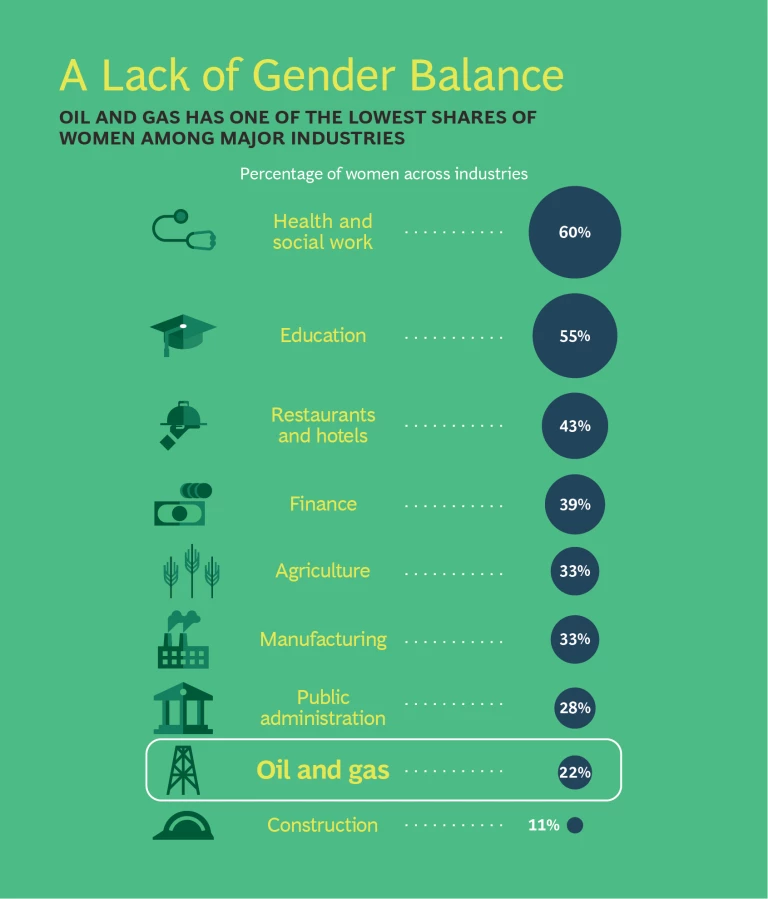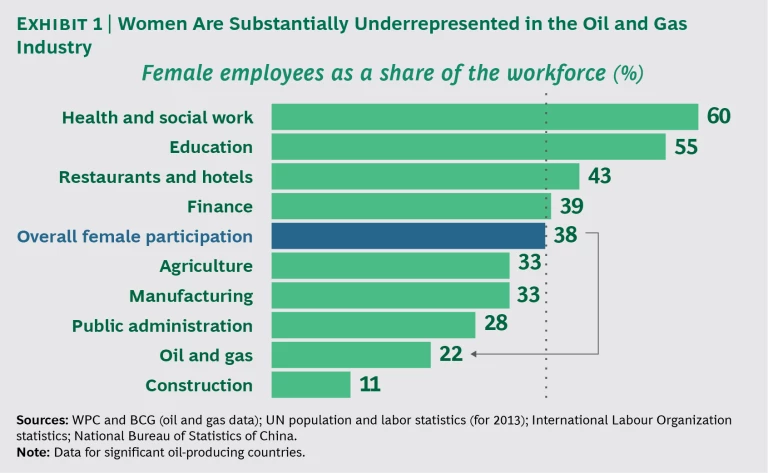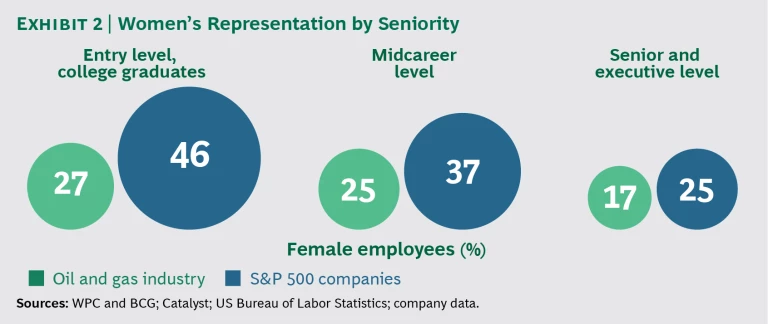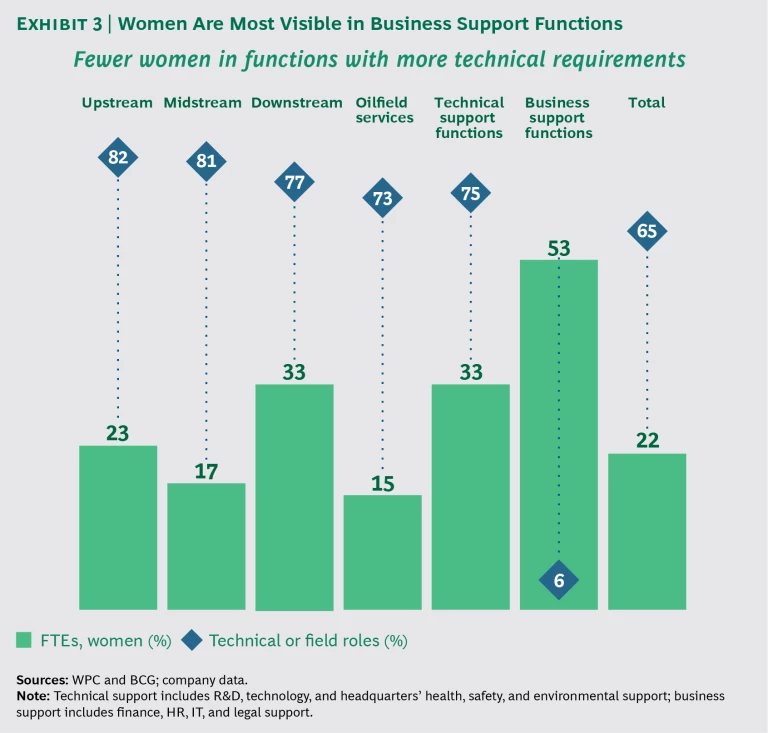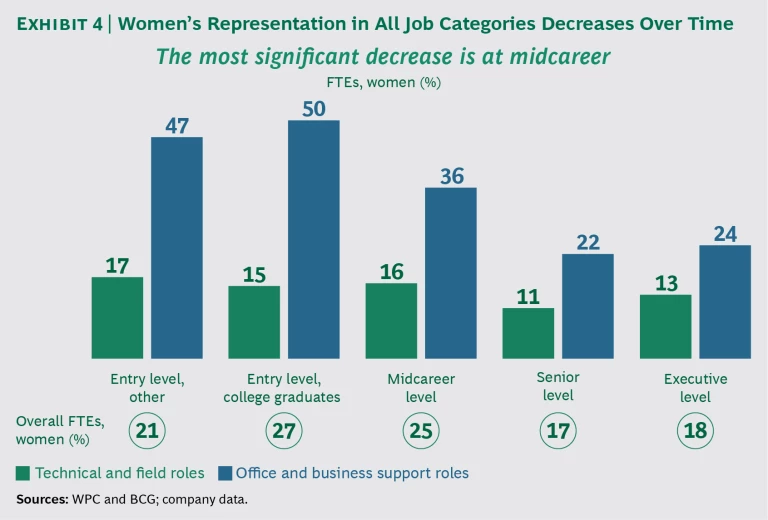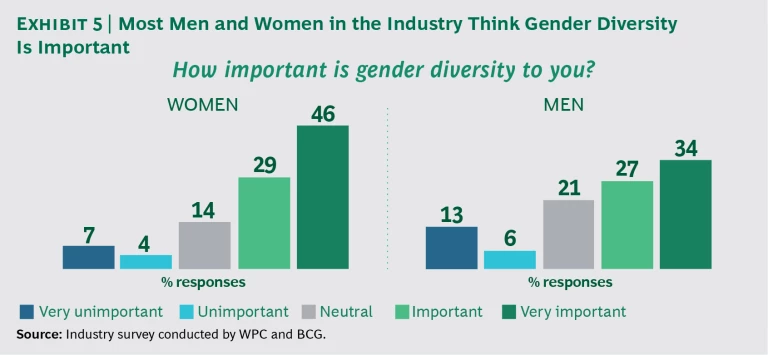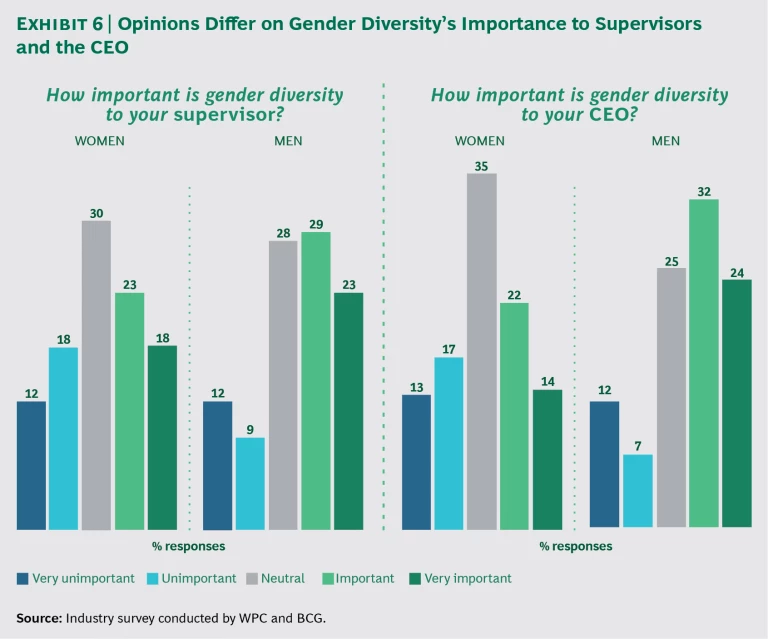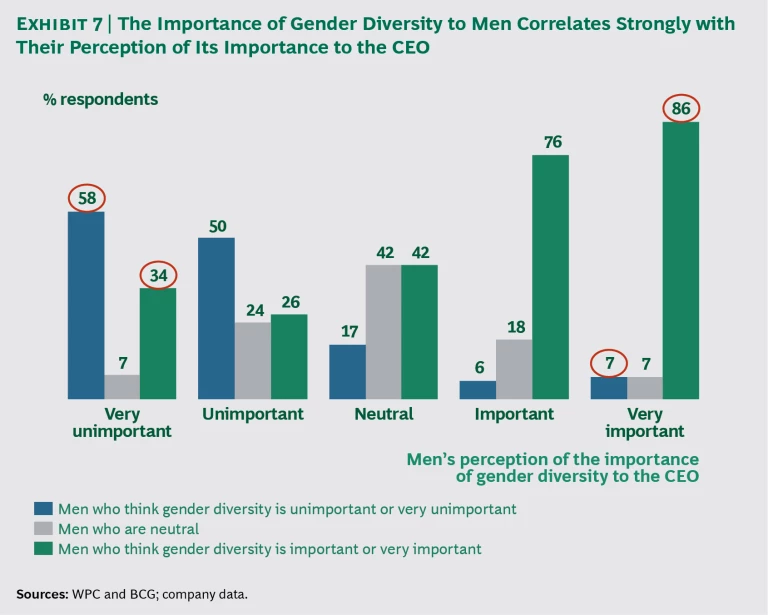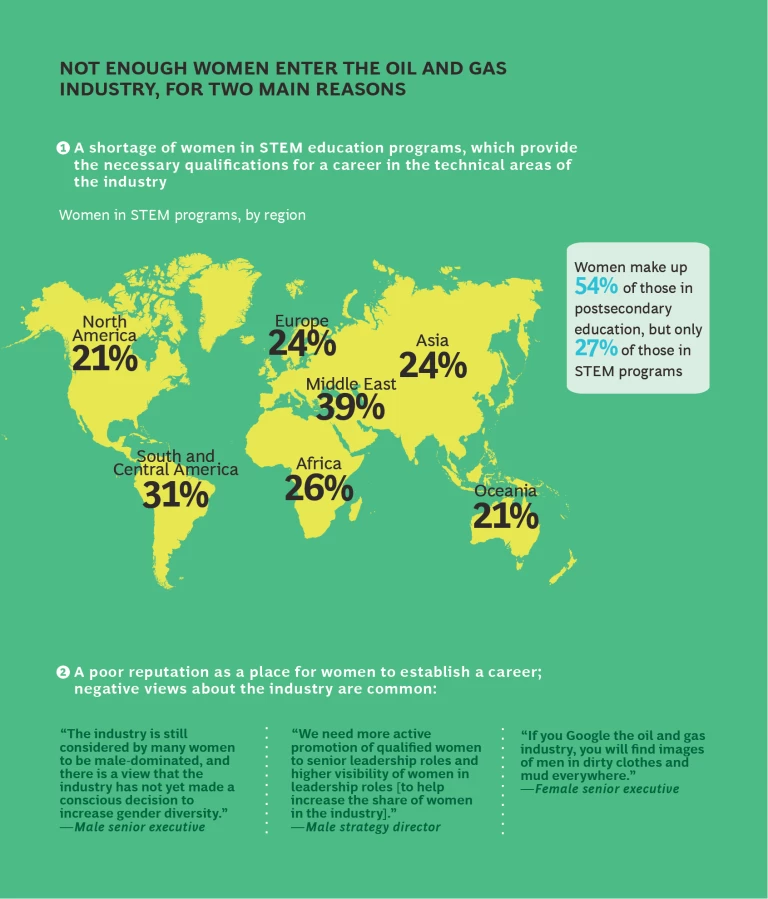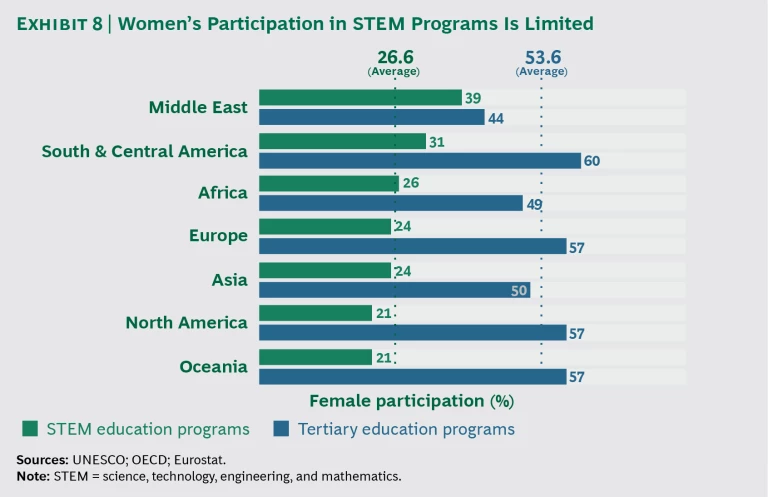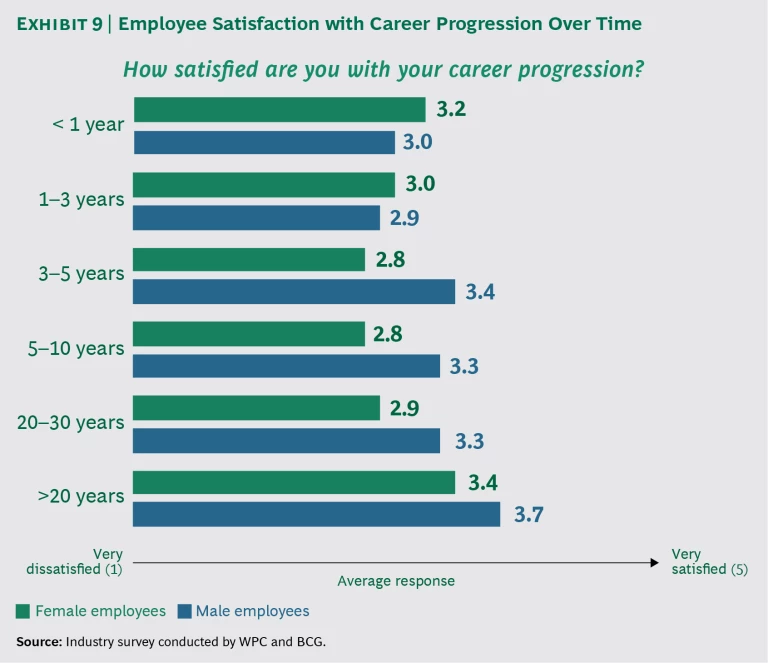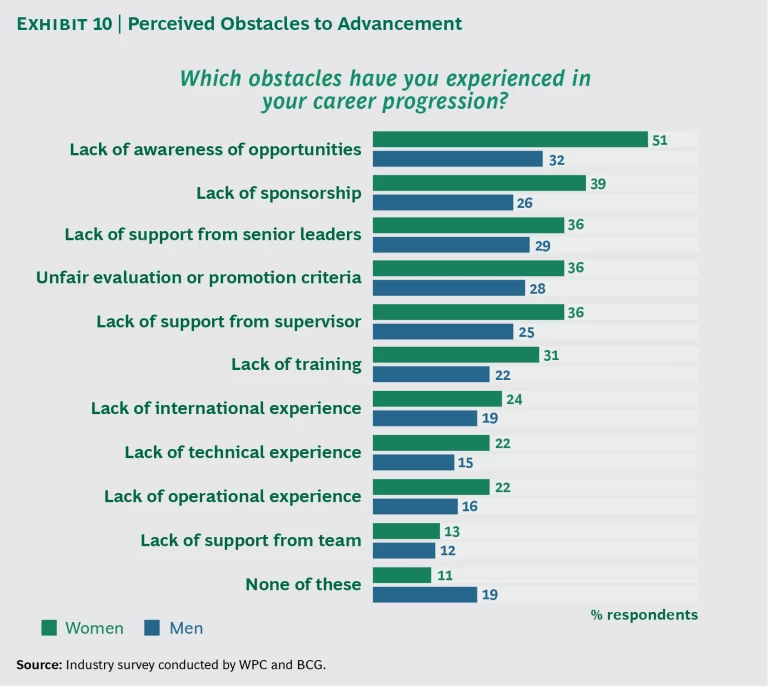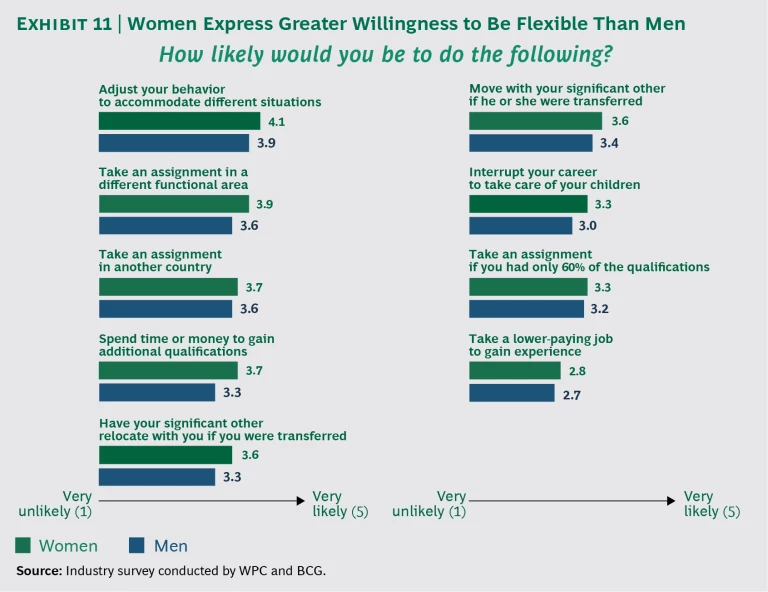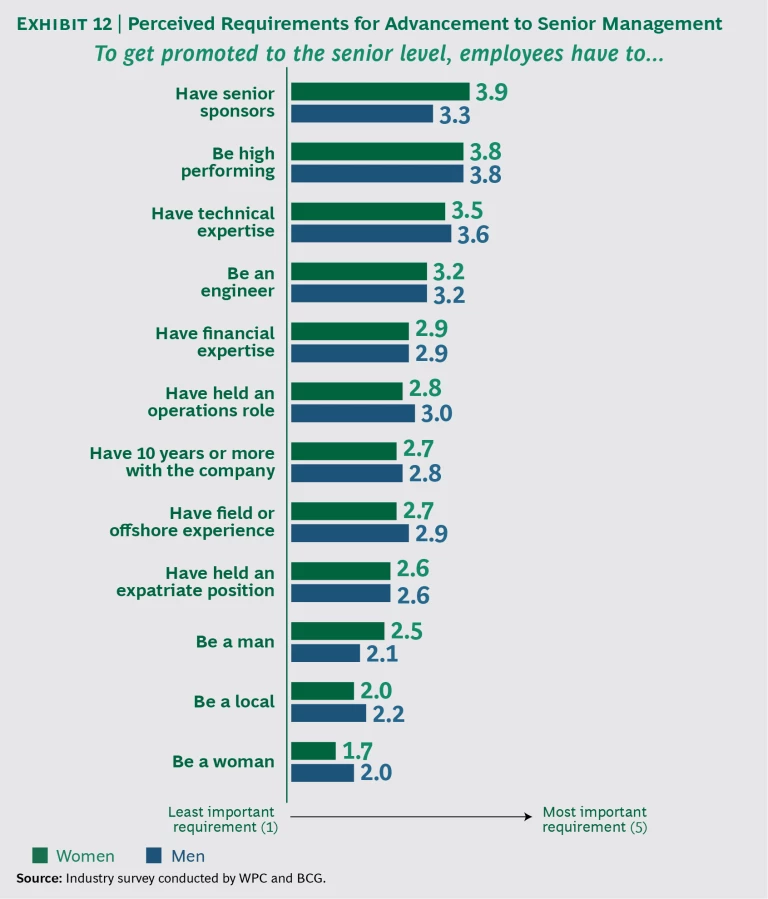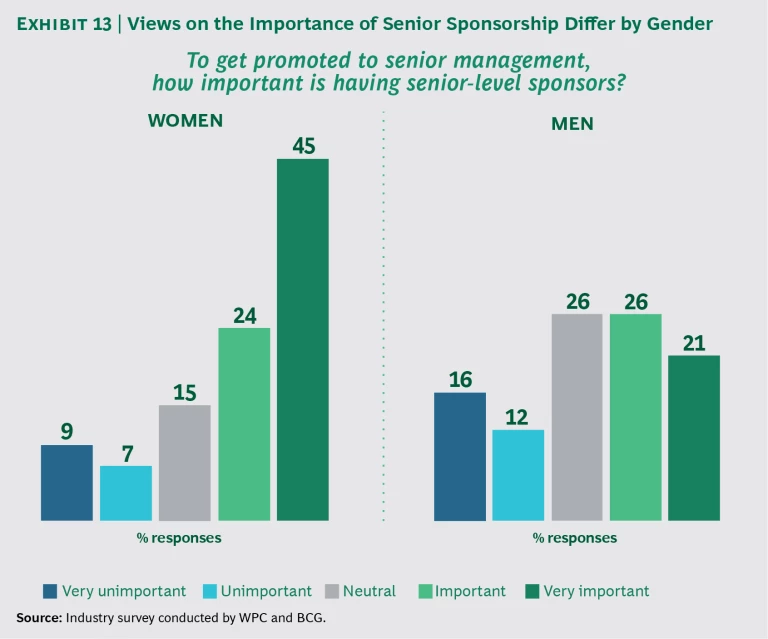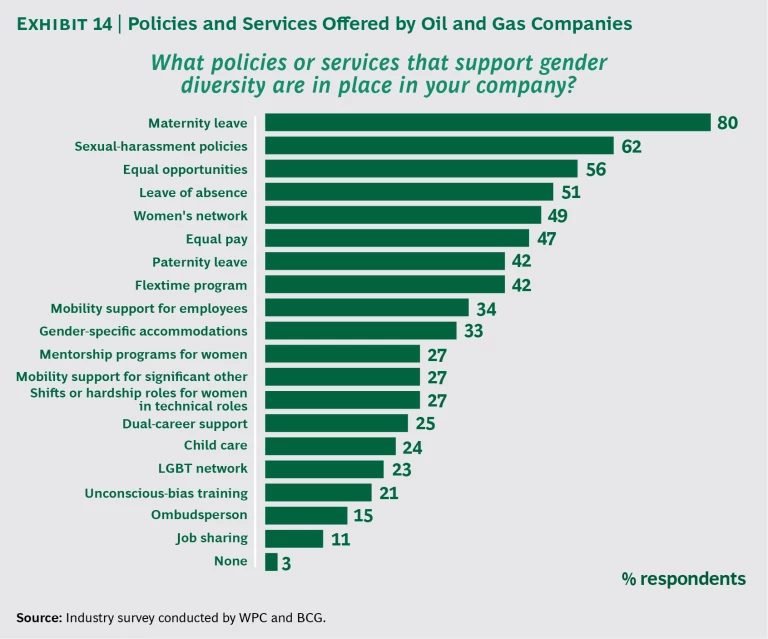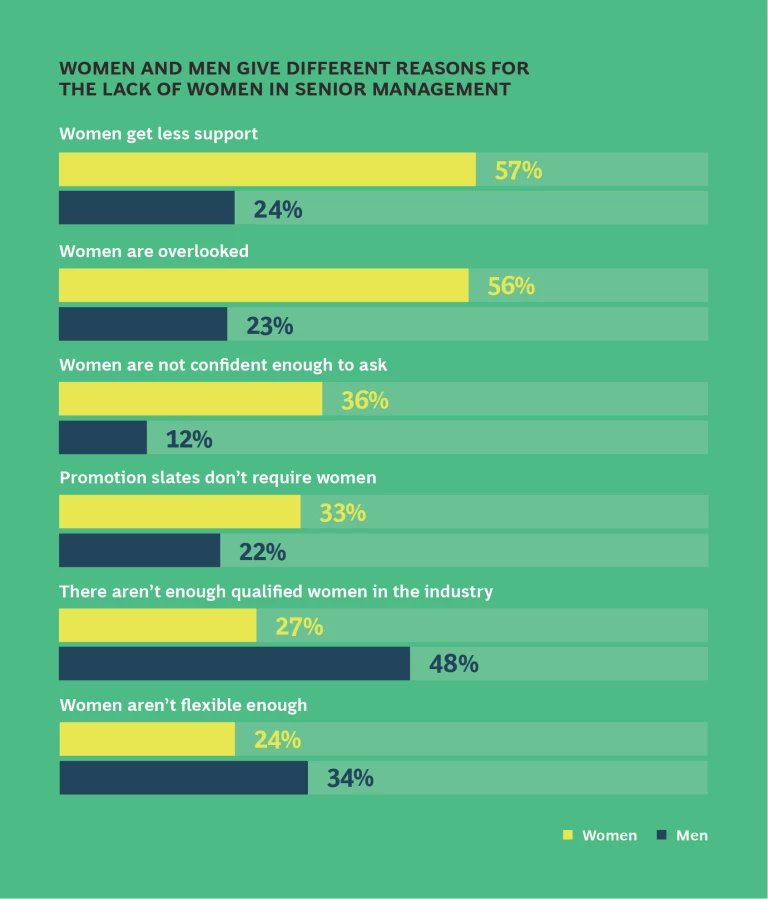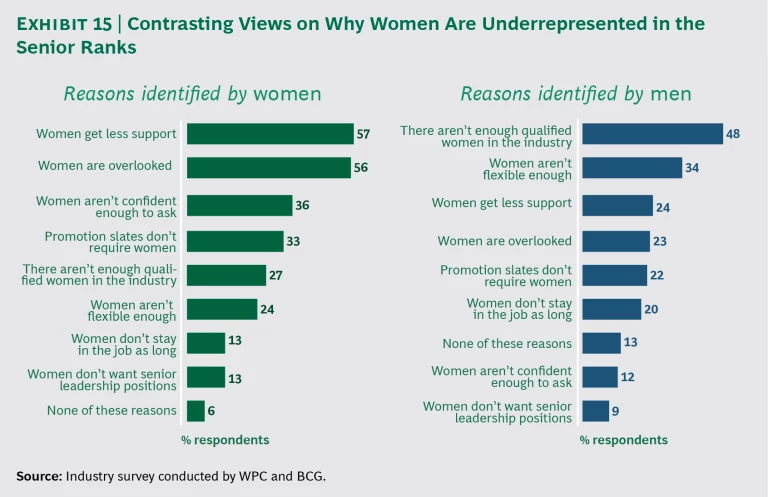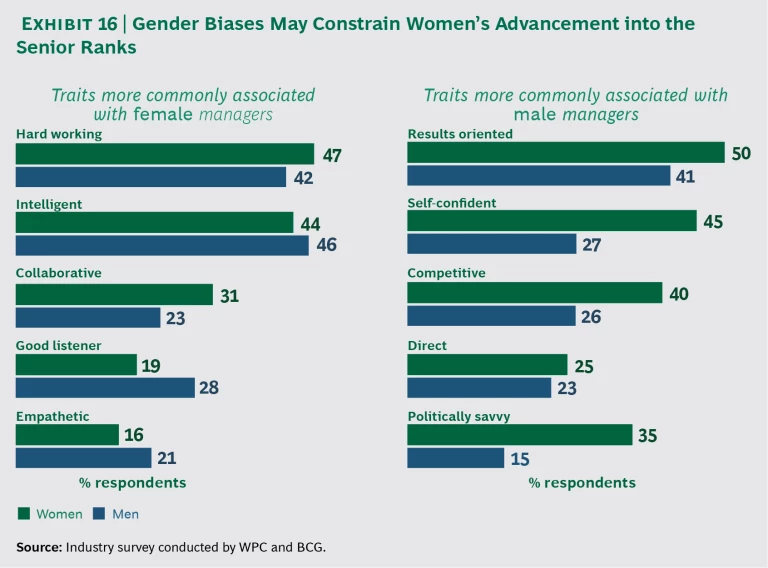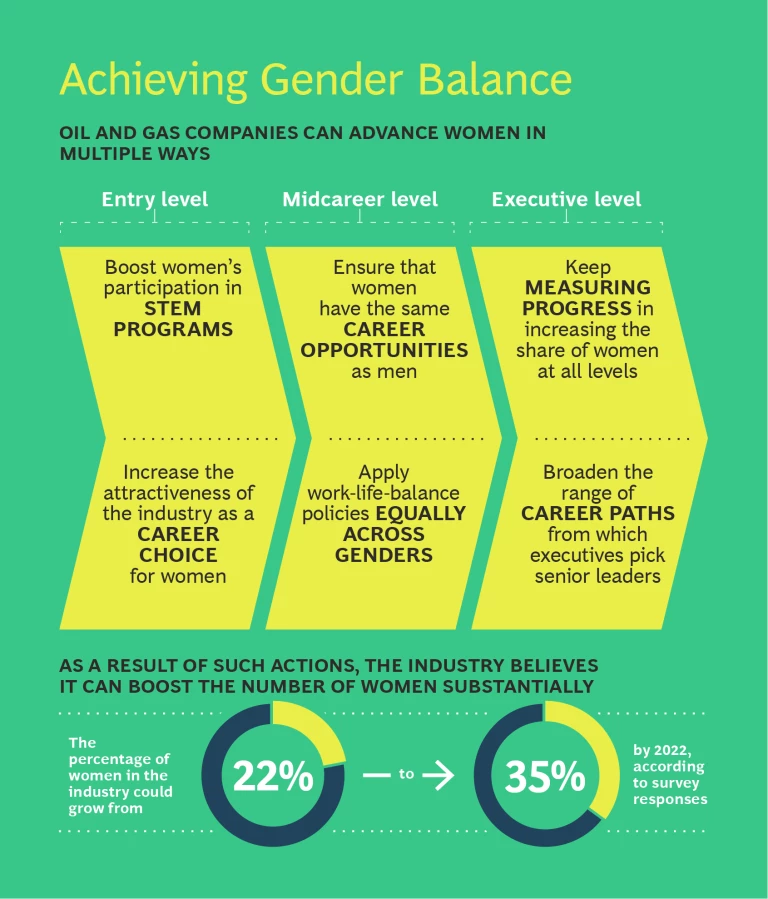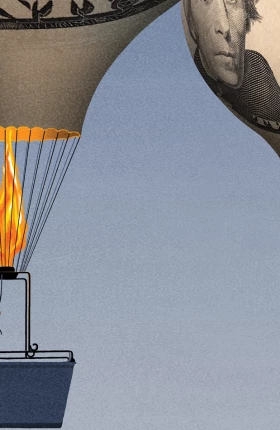PREFACE
This report, prepared by the World Petroleum Council and The Boston Consulting Group, is intended to provide a comprehensive baseline on gender balance in the oil and gas industry today. The report’s findings are based on substantial proprietary research that included detailed personal interviews with more than 60 male and female senior industry executives worldwide, a survey of approximately 2,000 male and female industry professionals from a wide range of companies and countries, and primary quantitative data provided confidentially by all major international oil companies and several national oil companies (a total of 38 companies with collective revenues of $1.9 trillion and employees representing between 25% and 30% of the industry’s global workforce). This substantial body of research provides what we consider to be a highly valuable in-depth and representative look at where the industry stands on this very important topic.
Beyond the rigor of its underlying research, our report is unique on several levels. It examines gender balance at three stages of career development—entry level, midcareer, and senior management—and draws on different perspectives to provide new insights into the challenges that women and companies interested in advancing gender balance face at each stage. The report also provides pragmatic recommendations for how these challenges can be addressed.
One high-level finding from our research that is worth noting here is the consistency of our survey results across geographies: despite in-depth analysis, we could not find any statistically significant differences among companies in different countries or regions. This consistency reflects the powerful influence of the industry’s current culture, which is global in scope and sufficiently strong to override the influence of regional forces. This culture will need to change materially if the industry hopes to make meaningful strides toward gender balance, as we discuss in detail in the report.
We plan to update this report every three years in conjunction with the triennial World Petroleum Congress. This will enable us to keep track of the industry’s progress in improving gender balance as well as the effectiveness of our recommended actions.
The World Petroleum Council and BCG hope that this report makes a major contribution to oil and gas companies’ efforts to boost women’s representation in the industry.
EXECUTIVE SUMMARY
Representing roughly a fifth of employees in the oil and gas industry, women account for a significantly smaller share of the workforce than they do in almost any other sector. These women also work disproportionately in office jobs; they have a very limited presence both in technical roles, which are often considered prerequisites for career advancement, and in upper management. The upshot: oil and gas companies are failing to fully leverage a potentially sizable and critical pool of talent.
The loss to the industry is threefold. First, oil and gas companies have a smaller number of highly qualified candidates to choose from when filling positions, especially in the middle and higher ranks, because many talented women either never join the industry or drop out prematurely. Second, these companies miss out on the higher quality of teamwork, diversity of perspectives, and creativity in the solving of technical and business problems that characterize those with larger percentages of female employees. Third, the industry’s relative lack of gender diversity, particularly in the senior ranks, hurts its reputation among women as a career choice. This can create a vicious circle, with the industry finding it progressively more difficult to recruit women across the board.
The combined effects could ultimately weigh heavily on oil and gas companies’ ability to increase capital productivity, which will be vital as they wrestle with the challenges posed by the potential large-scale retirement of many experienced employees, an ongoing uncertain oil price environment, and advances in robotics and artificial intelligence that could reshape the industry in a host of ways.
But attracting and retaining greater numbers of women, particularly those with optimal backgrounds and skill sets, will pose challenges for the industry. These include the limited number of girls and women pursuing technical educations, structural barriers within the oil and gas industry that make it difficult for women to advance and to balance work and family, and an established male-centric culture that remains prevalent throughout much of the industry. We strongly believe, however, that the industry can and must surmount these challenges and close the gender gap if it hopes to position itself optimally for tomorrow.
The following are the key findings of our report:
The percentage of women in the industry’s workforce drops over time and falls particularly sharply—from 25% to 17%—between the middle-management and senior-leadership career stages. This trend won’t change unless CEOs make gender diversity a higher strategic priority. Although 56% of men believe that their CEO considers gender diversity important or very important, only 36% of women do. CEO commitment matters because many employees, especially men, take their lead from the CEO. Of men who think their CEO considers gender diversity very important, only 7% consider it unimportant or very unimportant themselves, while 86% consider it important or very important. Conversely, of men who think their CEO considers gender diversity very unimportant, 58% likewise consider it unimportant or very unimportant, while only 34% consider it important or very important.
Although men and women start out on an equal footing, women rarely reach the top of the organization. This isn’t owing to a lack of ambition: our research shows that women are just as ambitious as men. So what’s the reason? Men, especially those in senior positions, attribute the phenomenon largely to a shortage of qualified female candidates. This assessment is probably accurate: among women who have spent many years in the industry and might otherwise be considered suitable candidates for promotion to senior management, many have failed to accumulate the critical experiences that their male colleagues have. Thus, even among women who are still at the company after 15 to 20 years, the odds of landing a senior executive job are small: women hold less than 20% of these positions.
There are wide gaps in perception between men and women regarding the gender-related challenges that women face. For example, men believe that women are generally less flexible than men and therefore less suited to certain roles, including many expatriate positions and jobs in the field. But our research shows that women are in fact just as flexible as men, and sometimes even more so. The differences in opinion between men and women about the challenges women face are particularly evident with regard to women’s underrepresentation in the senior ranks. Fifty-seven percent of women said that female employees receive less support for advancement into senior positions than male employees; only 24% of men agreed. Fifty-six percent of women said that women are overlooked for senior positions; only 23% of men agreed.
Unless companies develop a critical mass of women across all roles, meaningful progress toward gender balance in the industry will not occur. Many oil and gas companies are making a genuine effort to improve gender diversity through recruiting practices, work-life-balance policies, and other means. But these measures have not produced the desired results, in large part because they are too hands-off, failing to focus on meaningful quantitative targets. While an average 22% of jobs in the industry are filled by women, a look at specific job categories tells a different story. College-educated women hold fully 50% of entry-level office and business-support positions, but they hold only 15% of entry-level technical and field positions.
There are many actions the industry can take to increase the number of female employees and accelerate its progress toward gender balance. The industry must look holistically at the various functions—especially technical ones, where women’s representation is particularly low—and establish targets that will boost women’s presence to the point of critical mass. The industry should also take specific actions centered on three critical career stages:
- At the entry level, the industry can expand the talent pool it draws from by taking steps to increase women’s participation in STEM programs. It can enhance its attractiveness to women as a career choice by promoting the wide range of jobs available and making career paths more flexible, working with governments to remove structural barriers that make it difficult for women to work in the industry, and increasing the number and visibility of senior female role models.
- At the midcareer level, the industry can work to ensure that women have the same career opportunities as men, that each woman has a sponsor who can offer career guidance, and that work-life-balance policies are available and applied equally to male and female employees.
- At the senior-leadership level, the industry can provide stretch goals for women and the necessary support to help them succeed, broaden the range of career paths from which senior leaders are picked, and ensure that standards for promotion are applied equally to men and women.
Greater gender balance is a worthwhile and attainable goal for the industry, and one that it has the means to achieve. Provided that leadership commitment, especially from CEOs, remains sufficiently strong, the industry could boost women’s representation steadily and materially over time—and reap a host of benefits, including improved organizational performance, creativity, decision making, and morale.
GENDER BALANCE: A STRATEGIC PRIORITY FOR THE OIL AND GAS INDUSTRY
Oil and gas companies are in significant need of talent. The industry faces sizable challenges, including those posed by the still uncertain, “lower for (much) longer” oil price environment and ongoing, potentially game-changing technological advances (such as in robotics and artificial intelligence). If and when oil prices stage a significant and sustained recovery, the industry will also need to replace some or all of the approximately 350,000 workers estimated to have been laid off in the industry’s recent downturn. Compounding matters, oil and gas companies will have to contend with the industry’s pending “crew change,” that is, the retirement of many of its most experienced employees aged 50 or older, who make up nearly three-quarters of the current workforce.
The Industry Today
The numbers are stark. Women constitute 38% of the workforce in major oil-producing nations but only 22% of employees in oil and gas. In only one major industry—construction—do women constitute a smaller percentage of employees. (See Exhibit 1.)
Women’s underrepresentation in the industry spans all levels but worsens with rising seniority: women fill 27% of entry-level roles that demand a college degree, 25% of mid- career-level roles, and 17% of senior and executive-level roles. Only 1% of the industry’s CEOs are female. As one male survey respondent said, “Where I work, women are like oxygen: less and less as you go up.” These percentages are well below the corresponding percentages for women in S&P 500 companies. (See Exhibit 2.)
This substantial underrepresentation of women holds across all regions and types of company: international oil companies, where women represent 26% of employees; national oil companies, where they represent 13%; and oilfield services and equipment companies, where they represent 16%.
Women are also underrepresented across most roles and job categories in the industry. But their presence is particularly limited in technical roles and jobs in the field, which are often considered to be prerequisites for advancement. Women hold between 10% and 30% of most of these jobs, an imbalance that can come at a sizable cost, since women in these positions often find themselves talked over in meetings and otherwise struggling to command the same attention and respect afforded to men. Over time, this can seriously erode women’s self-confidence and enthusiasm.
Finally, women are significantly underrepresented in expatriate jobs, which are often stepping stones to more senior roles. Women hold only 10% of these positions globally—despite the fact that they are often more willing than men (36% versus 28%) to accept an assignment in another country. Among employees under the age of 55, women are fully twice as willing as men to take on an expat role—50% of women versus only 25% of men. (Note, however, that over age 55 the percentages reverse, with women far less willing than men to take foreign assignments.) This pattern is consistent across most regions. Only in Africa and Latin America are men much more willing to take foreign assignments than their female counterparts. In these regions, 70% to 80% of men say they would take on such assignments, compared with only 20% to 30% of women.
Women tend to be most visible in corporate business-support functions, such as finance, human resources, and legal. (See Exhibit 3.) Overall, the share of women employed in these functions is 2.5 times their share in technical and field roles. It is also worth noting that, where women are employed in technical segments, they are more likely to hold office jobs than purely technical ones.
The underrepresentation of women in critical roles and job types is not necessarily indicative of industry passivity in the face of gender imbalance. Indeed, many companies have made concerted efforts to boost women’s presence in their organizations. However, women’s underrepresentation does confirm that the industry’s approach is often too hands-off and not focused sufficiently on meaningful quantitative targets. Until the industry moves more aggressively in this direction, the problem will persist.
Women’s representation in all job categories decreases over time and tends to fall most sharply between the middle-management and senior-leadership career stages. Women hold 15%, 16%, and 11% of entry-level (college graduate), midcareer-level, and senior-level technical and field positions, respectively; they hold 50%, 36%, and 22% of entry-level (college graduate), midcareer-level, and senior-level office and business support roles, respectively. (See Exhibit 4.)
Recognition of the Challenge
The majority of men and women in the industry—61% and 75%, respectively—say that gender balance is important or very important to them personally. (See Exhibit 5.) And there is general acknowledgment of the gender diversification challenge facing the industry. “The oil and gas industry could take a few pointers from the tech industry on gender diversity,” said a male executive whom we interviewed. “Our industry is extremely archaic. Change is necessary.”
But opinions differ along gender and seniority lines about the extent of the problem. While 76% of women believe that the industry is behind other industries in advancing gender balance, only 57% of men feel that way. And while 66% of men in senior-leadership positions—those who can most effectively drive change—believe that the industry lags behind other industries, only 54% of men below senior levels agree. Some senior male executives also acknowledge the problem but question how quickly it can be remedied, notwithstanding the industry’s best intentions. “It has been a male-dominated field since the beginning of time,” said one. “It will take years to change that.”
There are also differences of opinion regarding how big a priority gender diversity is for company management. While only 41% of women believe that their supervisor considers gender diversity important or very important, 52% of men do. Perceptions about the CEO’s commitment are even more divergent: only 36% of women believe that their company’s CEO considers gender diversity important or very important, versus 56% of men. (See Exhibit 6.)
These perceptions matter. While women are consistent in the importance they place on gender diversity, men place a greater priority on it when they believe that the company’s senior leadership cares about it as well. Of men who think that their CEO considers gender diversity very important, 86% consider it important or very important themselves. (See Exhibit 7.)
Executives and board members take a much more bullish view of the CEO’s support for gender diversity than the rank and file do: 70% of male and 63% of female executives believe that gender diversity is important to their CEO. There are several possible reasons for this. Executives and board members are in regular discussions with the CEO and may have a more accurate sense of his or her priorities than do those lower in the organization. Or CEOs may simply be doing a better job of communicating their commitment to gender diversity to the company’s upper ranks than to those “on the ground.” Said one female respondent to our survey, “The issue needs much more pull from executive management; senior leaders need to role model what they say.” Another observed, “Policies are one thing, acting upon them another.”
The reality may be different, but few employees believe their supervisor is assigned goals that foster gender diversity. Only 20% of women and 31% of men think their supervisor has relevant benchmarks or KPIs that he or she is measured against. Even at senior levels, only about 30% of men and women think their supervisor has diversity goals and accountabilities. The majority of both women and men believe that supervisors are more likely to attach importance to gender diversity when they have concrete objectives to meet.
ENTRY LEVEL: STRENGTHENING THE INFLOW OF WOMEN
Increased gender diversity has been associated with a number of benefits to organizational performance, including improved problem solving, greater creativity, and lower-risk decision making.
Step one in improving the industry’s gender balance is to increase the number of qualified women in the industry at the entry level. This will entail tackling two major challenges. The first is boosting the limited presence of girls and young women in STEM (science, technology, engineering, and mathematics) programs, which provide the necessary qualifications for a career in the technical areas of the industry. These qualifications include not just the classic “petrotech” skills but, increasingly, computer science skills as well, which are becoming more and more important given ongoing advances in robotics and artificial intelligence. The second challenge is improving the industry’s poor image as a career choice among young women.
Women’s Limited Presence in STEM Programs
Women constitute a relatively small portion of students in the world’s STEM programs—between 20% and 30%, on average. (See Exhibit 8.) This is well below the level of women’s participation in tertiary education overall, which is between 50% and 60%.
The challenge for oil and gas companies goes beyond women’s limited presence in these programs, however. Even in regions where women’s participation in STEM programs is relatively high, such as the Middle East (about 39% female participation) and Central and South America (31%), many women ultimately do not enter the job market or do not enter it in their field of study. This is largely because of social or cultural factors—such as the stigma associated with certain professions or types of work for women—and structural barriers, such as laws in certain countries prohibiting women from doing shift-based work. Further, many young women who do enter and complete STEM programs ultimately shy away from the oil and gas industry, specifically, because of its generally poor image among women as a career choice.
Interestingly, participation in STEM programs by women in developed countries is typically lower—as little as 20% in some disciplines—than by women in developing countries. Recent studies suggest that a major reason is the effects of stereotyping on children in developed countries. In particular, the assumption among both boys and girls that males are more intelligent appears to be significantly influencing the beliefs and choices of girls and young women in these countries. One result is that girls in developed countries are less likely to enroll in STEM programs.
A concerted effort by governments, corporations, educators, and other stakeholders to boost women’s participation in these programs could drive participation rates higher. But meaningful change will take time—likely a generation—to materialize.
The Industry’s Image Problem
The industry’s poor image among women poses a substantial impediment to recruitment. Many women regard the industry as male-centric and as rigid and outdated in its practices and mindset—including its attitude toward women. Said one male senior executive, “The industry is still considered by many women to be male dominated, and there is a view that it has not yet made a conscious decision to increase gender diversity.” The industry’s challenge in overcoming this perception is compounded by a shortage of female role models in senior leadership positions. “There are almost no women at higher levels of the organization,” said another male executive.
The industry is also perceived to require travel and frequent relocation, and much of the work is thought to be dirty and physically demanding. Said one female senior executive, “If you Google the oil and gas industry, you will find images of men in dirty clothes and mud everywhere.” This point was echoed by a male senior executive: “There is a perception of roughnecks, which is hard to change and creates an unappealing image of the industry for women.” In fact, there is a broad spectrum of roles for prospective employees, both male and female—and, with the advance of digital technologies, those roles are becoming even more diverse and numerous. But the image persists.
Many potential female recruits also assume that a strong technical background is critical to advancing in the industry and therefore decide not to apply. While a technical background is indeed advantageous—”Real-world experience can be important,” acknowledged one male executive—there are many routes to the top. Ultimately, the most important determinants of success are talent and effort: more than half the senior executives we interviewed stressed that advancement to higher ranks hinged to a large degree on “working hard” and “being good at what you do.” Said one male executive, “It’s a bottom-line business. If you can produce, you will be successful.”
Recommendations
How can the industry overcome these challenges? It can expand the size of the talent pool from which it draws and increase the number of women within its ranks in several ways:
- Promote STEM programs among girls and young women, and offer scholarships and internships to high-potential female students. The long-term importance to the industry of such efforts can’t be overemphasized. “It’s challenging for the industry to find qualified female candidates when so few choose to study engineering,” said a male executive. “I think the effort has to start in high school, with strong leaders and mentors encouraging girls to pursue these fields.”
A number of industry players are already active on this front. Hungary’s MOL Group, for example, provides financial support and skills development opportunities to outstanding female full-time students from selected universities who are pursuing degrees in geosciences, petroleum engineering, chemistry, petrochemicals, and other MOL-relevant STEM subjects. In Austria, OMV Group’s Technikqueens educational initiative is designed to immerse girls aged 14 to 16 in technology and encourage them to choose a technical career path. ExxonMobil’s “Introduce a Girl to Engineering Day” program seeks to inspire middle-school girls in the US to explore coursework and careers in engineering through hands-on experience provided by the company’s employees. While such efforts will take time to bear fruit, the eventual deepening of the talent pool will benefit the industry for decades to come.
- Establish clear recruiting targets for men and women, and develop appropriate KPIs for attracting and retaining women. Santos, for example, established a 50/50 recruiting target as part of an effort to increase the percentage of women in technical roles from 12% to 25%. Shell has set a target of 50% women among the college graduates it hires. Chevron also has a 50% female recruitment target.
- Consider outside-the-box approaches to recruitment. A senior executive at an international oil company told us that she was recruited into her first industry job through a cold call the company made to all promising engineering students in her class; before the call, the industry had not been on her radar screen. Such an approach could be particularly effective in wooing attractive candidates in STEM programs with relatively large numbers of female participants.
- Promote the wide range of roles available in the industry, from jobs in engineering to jobs in supply chain operations, environmental management, and geological research. Companies can also emphasize to potential recruits that the range of roles available stands to widen further over time.
- Actively foster greater flexibility in women’s careers, especially in the early stages. Digitalization will be a critical enabler: as it advances, it will be possible for more jobs to be executed remotely, creating greater job flexibility. Also, with rising numbers of women looking to work abroad, companies should highlight opportunities for them to take on expat roles early in their careers.
- Work to remove structural barriers that thwart women’s advancement in the workforce and particularly in the oil and gas industry. Proactively engage with legislators to promote change in countries that limit women’s participation in the industry through, for example, laws and regulations that prohibit them from taking field roles or doing shift work.
- Develop a larger number of visible female role models in the industry’s senior ranks. Our survey confirmed that women are much more inspired by women than by men in leadership positions. The value of visible female senior leaders can be enhanced further by making them accessible both to recent female entrants to the job market and to female employees who are new to the industry. One international oil company, for example, has benefited from the creation of a network of successful women within the company that acts as an avenue for mentorship.
MIDCAREER: MAINTAINING WOMEN’S ENTHUSIAM
Once a woman has moved through the entry-level stage, how is the next phase of her career in the oil and gas industry likely to unfold? For many women, it is likely to be characterized by rising dissatisfaction with their career progression, especially relative to that of men. The drop in women’s satisfaction with this aspect of their work first surfaces at the three- to five-year mark. (See Exhibit 9.) Not coincidentally, it is precisely at this point that it becomes progressively harder for the industry to retain female talent.
Women’s satisfaction with their work starts to wane in midcareer for many reasons. The three most critical are lack of access to job opportunities, lack of sponsorship for career advancement, and the challenge of balancing career and family.
Lack of Access to Opportunities
Women are eager to advance their careers. But many believe that they face a unique set of challenges on this front relative to men. The challenge that women identified most frequently was a fundamental one: lack of awareness of career advancement opportunities. (See Exhibit 10.) Indeed, this was cited by fully half the women surveyed (compared with only 32% of men) as an obstacle they had faced. As one female executive put it, “My role as a senior female leader is to challenge the beliefs and assumptions of my male colleagues when we’re making promotion decisions. Sometimes a male colleague, in discussing a woman under consideration, will say, ‘She just had a baby, she won’t want to make the move that this position demands.’ To which I’ll respond, ‘Have you asked her?’ The answer, typically, is no.”
This is not a singular example. We hear frequently, from both women and men, that many job opportunities are simply not presented to women, even to those who clearly possess all the necessary qualifications. This is often because men assume that women are unwilling or unable to assume more senior positions because they lack the required flexibility. But in fact many women are quite willing to take on these roles and to do what is necessary to succeed in them. More women than men surveyed said they would be willing to take on a role that might advance their development—even if it was not attractive in terms of pay, location, or immediate impact on their career advancement. More women than men also said they would be willing to spend time or money in order to gain additional qualifications, to take an assignment in a different functional area or country, to accept a lower-paying job in order to gain experience, and to have their spouse or partner relocate with them if they were transferred. (See Exhibit 11.) Yet biases against women based on their perceived lack of flexibility remain prevalent.
Women are often bypassed for other reasons as well. For instance, a senior female executive at a national oil company told us that managers tend to favor men for offshore work because the logistics are easier to manage: with male workers, there is no need for the company to provide extra facilities, such as bathrooms and changing rooms. This view was echoed by a US geophysicist, who reported that his company considers an additional trailer for women engaged in shale gas operations a “discretionary expense.” The lack of such separate facilities for women can result in awkward, compromising, or even criminal violations of privacy. One female CEO offered this advice: “If they don’t provide you with separate bunk beds, bathrooms, etcetera, they don’t care about you and you’d better go look for someone who does.”
Lack of Sponsorship
Another major reason that women’s satisfaction drops noticeably at the three- to five-year mark is perceived inequity in the promotion process. When asked to rank the relative importance of criteria for advancement to senior management, specifically, women identified “having senior sponsors” as the single most critical requirement, reflecting the broadly held view that succeeding solely on their own merits is difficult because of gender bias. (See Exhibit 12.) “Latent sexism is apparent at all generations of oil and gas,” said one women executive. “The young guys have it too.”
Fully 69% of the women we surveyed consider senior sponsorship important or very important to their prospects for promotion to senior management, compared with only 47% of men. (See Exhibit 13.) Women said that senior sponsorship is particularly critical to their prospects for promotion in cases where the CEO does not care about gender diversity. These views on the importance of senior sponsorship are consistent across all regions.
Many women also highlighted sponsorship- and support-related issues as hurdles to their career progression generally. Thirty-nine percent of women identified lack of sponsorship as a challenge (versus only 26% of men), and 36% of women said that lack of support from senior leaders had been an obstacle (versus 29% of men).
The Challenge of Balancing Career and Family
Although not vital, international, technical, operational, or field experience can be highly advantageous to an employee’s long-term prospects in the oil and gas industry. Many women who recently joined the industry think it is particularly critical and attach considerable importance to acquiring it.
Current career paths in the industry are rigid and fairly predetermined, with milestones measured by a specific sequence of postings and professional experience. In midcareer, leadership and management roles in the international arena and in the field—such as refinery manager and director (or managing director) of upstream operations—are considered important boxes to check in order to be considered for executive positions later on.
This sequence poses a difficult challenge for many employees who have children, especially since turning down an appointment at an inflection point in one’s career can preclude further advancement. This is true for both women and men—and probably more so for men. For example, we were told about a male employee with five children who declined a more senior position because he was concerned about the job’s potential impact on his family life; he has been overlooked for other positions ever since, despite continuing to perform at a very high level.
Senior executives are aware of the challenges for parents but are divided on the career implications. In our interviews, opinions ranged from those who believed that “you can’t have it all” (that is, a family, a career, and time for yourself) to a smaller number who disagreed but emphasized that making it work demands skillful management of the logistics. It is worth mentioning that many pointed out that the challenges facing parents in the industry are almost identical to those facing young parents generally, with many dual-income millennial couples struggling to balance the demands of two careers.
A number of companies have instituted policies, including the option to take a leave of absence, that offer more flexibility and help both male and female employees improve their work-life balance. (See Exhibit 14.) Relatively few of our survey respondents, however, were aware of all the policies available at their company, including dual-career support and help for employees and their spouses and partners with the costs and logistics involved in relocating. Other respondents told us that their company had talked about instituting such policies but had not followed up.
Some of the employees we interviewed were of the opinion that oil and gas is behind other industries in leveraging the policies and services that promote more-flexible career paths. Almost all of them strongly supported promoting paternity leave, as companies in other industries have done, in order to level the playing field for male and female employees. Facebook, for example, recently introduced equal, mandatory parental leave for men and women.
Even at companies where policies like these are in place, our survey indicated that their utilization by employees is generally quite low. For example, many are made use of by less than 30% of women and by even fewer men. When asked why they take so little advantage of these programs, about 70% of respondents (both women and men) said that they didn’t need them. At the same time, however, some women expressed concern that their utilization of such policies would be perceived differently from a man’s. Said one female executive, “If a father leaves work early to bring his son to soccer practice, he is seen as a good dad. If a woman does that, people say she cannot cope with the combination of family and job.”
Recommendations
Oil and gas companies can halt the creeping dissatisfaction that develops among female employees at midcareer by facilitating women’s advancement and by developing and promoting policies and services that support a better work-life balance for both genders.
- Ensure that women are made aware of and are offered the same career advancement opportunities that men are. Managers need to explicitly ask their female employees whether they want to take on a new role rather than assume that they don’t or can’t.
- Encourage women to make their career goals clear. Women should be encouraged to request career opportunities and not shy away from risk. At the same time, companies should take steps to ensure that assumptions about whether female employees have the flexibility required by certain positions do not influence job or promotion decisions.
- Create more-flexible career paths. Greater flexibility is especially called for in the timing of operational and field roles. Companies should give employees the opportunity to assume these positions earlier on in order to support both their professional advancement and their family life. A number of companies are moving in this direction.
- Insist on the development of separate and sufficient facilities and accommodations for women working in field roles. A strong majority, 70%, of the senior executives we interviewed identified this as an important enabler of increased diversity. Yet such facilities and accommodations are not commonplace in every region of the world. In designing them, companies should be sensitive to women’s preferences and perceptions. For example, one female executive we interviewed observed that women do not appreciate being accommodated in out-of-the-way locations that make them feel like their presence is an afterthought.
- Insist that every executive and senior manager take at least one talented female employee under his or her wing. Some of the female senior managers we interviewed said that they regret not having had the opportunity to support younger female colleagues. And several male senior managers remarked on how lucky they were to have had many highly talented women on their teams whom they could develop further.
- Formulate policies and offer services that make the industry more accommodating for both genders. Companies can improve retention of female employees, including senior leaders, by instituting policies and offering services that create a more supportive workplace, such as sabbaticals, part-time work arrangements, flexible leave, and international and other career opportunities. It is also crucial to ensure that these policies and services are communicated broadly throughout the organization and are well known and understood.
- Encourage utilization by both male and female employees of policies that encourage a better work-life balance. One female executive we interviewed understands the importance of this role: “I have had plenty of discussions with men on my teams about parental leave, and I generally encourage them to take it. I wish I had taken more time off for my two children.” Men, too, can help drive policy adoption. Several male senior managers, for example, noted that, in taking advantage of parental-leave policies themselves, they act as role models and encourage broader acceptance.
- Give women influential roles in developing these policies. At one international oil company, a “women and diversity network” plays a critical role advocating for policy changes (such as the formal institution of parental-leave policies and mandatory antiharrassment training) and the application of more equitable standards for all employees.
- Consider instituting job sharing where possible. More and more jobs, particularly predominantly data-driven ones, lend themselves to this strategy, and their number will continue to rise.
- Make policies that support gender diversity, such as bias awareness training, mandatory for all employees, especially leaders. Greater awareness can strengthen commitment to the cause. Having leaders attend the same meetings as the rest of the workforce also signals the priority that the company places on gender diversity.
SENIOR LEADERSHIP: INCREASING WOMEN’S REPRESENTATION AT THE TOP
Our study confirmed that the desire of women in the oil and gas industry to attain senior-leadership and executive-level positions is virtually the same as men’s. Fifty-five percent of female survey respondents on technical career tracks and 49% of those on business tracks said that they aspire to hold one of these positions; for men, the percentages were 54% and 55%, respectively. Yet women—including women who have been in the industry for 15 to 20 years—are substantially underrepresented in these roles, holding fewer than 20% of them. This stems from a confluence of factors.
An Old Boys’ Club
Many survey respondents and interviewees, both male and female, mentioned that they perceive an old boys’ club at the top of their organization, one that is basically impossible for women to join. This perception is common even among highly qualified women who have managed to check all the boxes considered prerequisites for attaining senior rank. Many women believe that the situation limits their access to critical decision makers who have influence over their careers, making it far harder for them to gain visibility among these individuals—and potentially sponsorship from them—than it is for their male colleagues.
One female executive, discussing the challenges that this environment poses for women, said, “You’ll hear ‘Nobody knows you’—which is code for ‘You are not part of the club and I am not willing to take on the risk [of sponsorship] for you.’” She continued, “It is often difficult for a woman to build the same relationships as a man could. It requires going golfing, drinking Scotch, or talking football. If you are a woman and not doing those things, there is a glass ceiling, people are not comfortable with you, and you don’t get close to them.” Said another female executive, “If you don’t like hunting or fishing trips, you’re at a disadvantage.”
Such an environment stacks the odds again women seeking advancement. Think about it. Whom is an executive more likely to champion for a managing director position: someone he has worked with and known for years through various professional and social engagements, or someone he has spent barely more than a few hours with at the occasional meeting?
Some women also reported that they sense an element of old-fashioned “chivalry” among senior male colleagues, reminding them of when few women worked in the industry. “My supervisor told me that he felt he had to ask his wife whether it was okay for him to talk to me by himself,” said one female executive. “I’m glad he ultimately did talk to me, as he gave me some great career advice.” It would not be too far-fetched to assume that, deep down, many male executives feel a degree of discomfort around women, further limiting women’s access to important decision makers.
Doubts About the Pipeline of Qualified Women
Women’s prospects for reaching senior-level positions also suffer from male opinions about the number of female employees who are suitable for those roles. (See Exhibit 15.) Indeed, when men were asked why there are so few women in senior roles, the top reason given was that there are not enough qualified women in the industry—nearly half the men who responded feel that way (only 27% of women agreed).
In fact their assessment is probably accurate: among women who have spent many years in the industry and might otherwise be considered suitable candidates for promotion to senior management, many have failed to accumulate the same critical experiences as their male colleagues and are hence at a fundamental disadvantage.
It should be noted that, while men think there is a shortage of qualified women in the industry, their opinion of female managers is generally high. Women managers were ranked higher than male managers on intelligence by both male and female respondents; they are perceived to have a high degree of confidence, especially by men in Europe, North America, and Africa; and they were given high rankings for ambition and skill. But one in three men also said that women lack sufficient flexibility to take on the roles and assignments necessary to be considered for senior positions. To reiterate our earlier discussion, this view is inconsistent with the flexibility that women themselves claim—which, as noted above, is generally higher than men’s.
Women take a different view of the reasons for their underrepresentation in the senior ranks. The top reason they gave is that they receive less support for their advancement than men; 57% of women feel that way, while only 24% of men agree. A majority of women (56%) also feel that the number of female employees at the senior level is low because women are routinely overlooked for consideration for career-advancing roles; only 23% of men agree.
Biases About Leadership Attributes
We asked male and female employees to identify the attributes that they associate with male and female managers. (See Exhibit 16.) On balance, male managers are associated with “harder” traits, such as being results oriented, self-confident, and competitive. Women are associated with “softer” traits, such as being collaborative and empathetic; they are also considered to be good listeners. These views are fairly consistent among men and women and correspond to common stereotypes. (Our data suggests, in fact, that women in the industry have stronger gender-based biases than men do.)
Why does this matter? Many job descriptions emphasize the harder traits more typically associated with men. (In a March 2017 online job listing for a project management position, for example, the listing company said it was seeking “dynamic and career-driven project managers” who “possess strong commercial acumen….”) This can be off-putting for women. Likewise, our survey and interviews indicated that, in decisions on promotions, senior managers, too, are inclined to attach greater importance to the harder traits. Indeed, very few companies in the industry are known for emphasizing collaboration or listening.
This puts women at a considerable disadvantage when they try to win senior-level positions. Some organizations recognize this and are attempting to strike a better balance between the harder and softer traits when decisions are made about promotions. An executive from one independent oil company, for instance, said that the company had just introduced six new traits, including one that emphasizes collaboration, to its evaluation criteria. The majority of executives, however, think that the decision criteria they currently use are generally balanced, even if not applied consistently.
Recommendations
Oil and gas companies can increase the number of women at the senior-management level by taking these critical measures:
- Provide women with stretch goals and the necessary support to achieve them. Several of the women we interviewed said they were grateful that, at important points in their career, they had been championed and supported by key individuals and been given roles that they would never have considered for themselves otherwise. These roles ultimately put them on a trajectory for senior-management positions.
- Talk shop with women. A female senior manager of a company’s downstream operations said that her career development discussions with women tended to focus on softer topics. As an antidote, she recommended that senior managers, both men and women, spend more time talking shop with female employees in order to give them a better understanding of the harder factors that help get results.
- Broaden the criteria for inclusion in the company’s list of high-potential candidates. Oil and gas companies tend to build lists of top candidates for promotion drawn from a small number of career paths—most populated disproportionately by men. Indeed, several executives (male and female) at an international oil company noted that women are entirely absent from their company’s list of “high potential” employees. Companies should expand the pool from which they draw. Any number of alternative career paths are well represented by talented women who, given their accomplishments and skill sets, should be considered for the senior ranks.
- Apply uniform standards when making promotion decisions. Consciously or not, decision makers often set the bar higher for women than for men. As one female executive observed, “Currently, men at our company are about ten times more likely to be promoted than women,” owing in part to higher standards applied to women. Companies should work to ensure that decisions are truly objective, taking into account only the qualifications of the respective candidates. Assumptions based on gender should not factor into the process.
MAKING IT HAPPEN
Imagine it’s 20 years from now. The oil and gas industry, like most other industries, has made significant progress toward gender balance. In fact, the industry has outperformed. Women are equally represented at nearly all levels; most strikingly, they now hold almost half of all CEO and executive positions. How has the industry achieved this?
We believe, as do many of the senior executives to whom we put the question, that the most critical factor will have been strong leadership and demonstrated commitment from the top of the organization, especially the CEO. Indeed, we think that the importance of such leadership to the industry’s progress toward increased gender diversity can’t be overstated. A number of executives whom we interviewed concurred:
The most important key success factor is the involvement of senior leadership. Leaders in the industry have to put women’s advancement at the top of their agendas. They have to be the catalysts of change.
—Female strategy manager,
Middle Eastern national oil company
Visible sponsorship, especially coming from a male leader, is highly important. When people see that action is being taken by the top, they’ll realize that the talk is not just lip service. The lower levels will follow what they see top leadership doing.
—Male oil and gas executive
CEOs must take ownership of this issue and align the entire organization accordingly. The change must be driven from the top down.
—Female strategy director,
Middle Eastern energy conglomerate
CEOs must have it in their hearts and minds to get there.
—Female director of operations,
international oil company
It takes a relentless bottom-up and top-down effort to reach gender diversity. This will not happen organically.
—Female HR manager,
independent oil and gas company
Of course, strong and committed leadership presupposes that leaders genuinely believe in the business benefits of increased gender diversity. Those benefits are by now well documented, so there should not be much skepticism. “There is ample data to support the idea that diversity improves performance,” said the female vice-president of an international oil company’s business unit. “If leaders believe, they will take the necessary actions.”
One of the most critical actions that leaders can take is to ensure that their company adopts an inclusive, gender-neutral approach to advancement, coupled with quantitative targets that support growth in women’s representation. More than three out of four of the senior executives we interviewed said that they thought an inclusive, gender-neutral approach to promotions was the most important factor in fostering greater gender balance. Two-thirds of senior executives also consider quantitative targets necessary to reach the point at which women’s representation at higher levels of the organization reaches critical mass.
Making such an approach work can be difficult. One consideration is the fact that no woman wants her success to be viewed as the result of a quota or some other numerical target. As one female senior executive said, “How can you exercise leadership effectively if there is the perception that you have been selected based on a KPI?” Another consideration is the potential effects of quotas on men and on how they perceive the company’s efforts to increase gender balance. Said one male executive, “The industry needs to do more to promote women, certainly. But this should not come at a cost of unfair discrimination against men.” Said another, “Ultimately, the best person for the job should get it. The bar should be raised to boost equality, not lowered.”
But companies can work to strike a balance. A female executive at one company, which she said has a “very strong performance culture,” described her company’s approach to the challenge: “All things being equal, we are more likely to put a woman into the job than a man in order to push the gender diversity agenda. But the ‘talent’ aspect still comes first, to ensure that the process is transparent and credible. We want to avoid ‘positive discrimination’ and make sure that those who really deserve the opportunities get them.”
A second vital action for leaders and their organizations is to work to instill in women greater confidence in themselves. This was the number-one response among female senior executives to the question of what could be done differently to promote larger numbers of women in the industry. “Women tend to underplay their skill set,” said a female vice-president of an independent oil and gas company. “They need to be encouraged to be more confident and assertive.” Another female executive said, “Lack of confidence among women leads them to shy away from taking responsibility.”
Women, especially those at the senior and midcareer levels, can play an important role on this front by more actively promoting other women in the organization when they have the opportunity to do so. One female executive advised, “Make other women look good. Don’t necessarily focus on yourself.” Another said, “Women can make it a point to highlight contributions from other women to help reinforce each other positively. If a woman says something worthwhile in a meeting, say, ‘That’s a great idea,’ or refer back to it by saying, ‘As Jane said…’.”
Ensuring that these and the other measures identified in this report deliver meaningful results will require a substantial ongoing effort from organizations and their leaders. But there is considerable optimism among both men and women that the industry can do this. And many believe that it won’t take anywhere near 20 years to see a significant difference. On average, the men and women we surveyed think the industry could boost the percentage of women in its workforce to 35%, from 22% today, within the next five years.
We look forward to continuing to track and report on the oil and gas industry’s progress toward gender balance. We encourage companies to continue to share their progress with us, and to participate in our surveys and interviews, so that we can make future editions of this report as comprehensive and useful as possible.
PROMOTING GENDER BALANCE
A Consolidated List of Recommendations
Entry Level: Strengthening the Inflow of Women
- Promote STEM programs among girls and young women, and offer scholarships and internships to high-potential female students.
- Establish clear recruiting targets for men and women, and develop appropriate KPIs for attracting and retaining women.
- Consider outside-the-box approaches to recruitment.
- Promote the wide range of roles available in the industry, from jobs in engineering to jobs in supply chain operations, environmental management, and geological research.
- Actively foster greater flexibility in women’s careers, especially in the early stages.
- Work to remove structural barriers that thwart women’s advancement in the workforce and particularly in the oil and gas industry.
- Develop a larger number of visible female role models in the industry’s senior ranks.
Midcareer: Maintaining Women’s Enthusiasm
- Ensure that women are aware of and are offered the same career advancement opportunities that men are.
- Encourage women to make their career goals clear.
- Create more-flexible career paths.
- Insist on the development of separate and sufficient facilities and accommodations for women working in field roles.
- Insist that every executive and senior manager take at least one talented female employee under his or her wing.
- Formulate policies and offer services that make the industry more accommodating for both genders.
- Encourage utilization by both male and female employees of policies that encourage a better work-life balance.
- Give women influential roles in developing those policies.
- Consider instituting job sharing, specifically where possible.
- Make policies that support gender balance, such as bias awareness training, mandatory for all employees, especially leaders.
Senior Leadership: Increasing Women’s Representation at the Top
- Provide women with stretch goals and the necessary support to achieve them.
- Talk shop with women.
- Broaden the criteria for inclusion on the list of high-potential candidates.
- Apply uniform standards when making promotion decisions.
Making It Happen
- Ensure that there is strong leadership and demonstrated commitment to gender balance from the top of the organization, especially the CEO.
- Adopt an inclusive, gender-neutral approach to advancement, coupled with quantitative targets that support growth in women’s representation.
- Work to instill in women greater confidence in themselves.
APPENDIX: DETAILS ABOUT THE COMPANIES THAT PROVIDED WORKFORCE DATA AND ABOUT OUR SURVEY RESPONDENTS
The workforce data that we assembled for this report was collected from oil and gas firms spanning a range of company types and geographies. Similar breadth characterized the industry professionals who responded to our survey.
